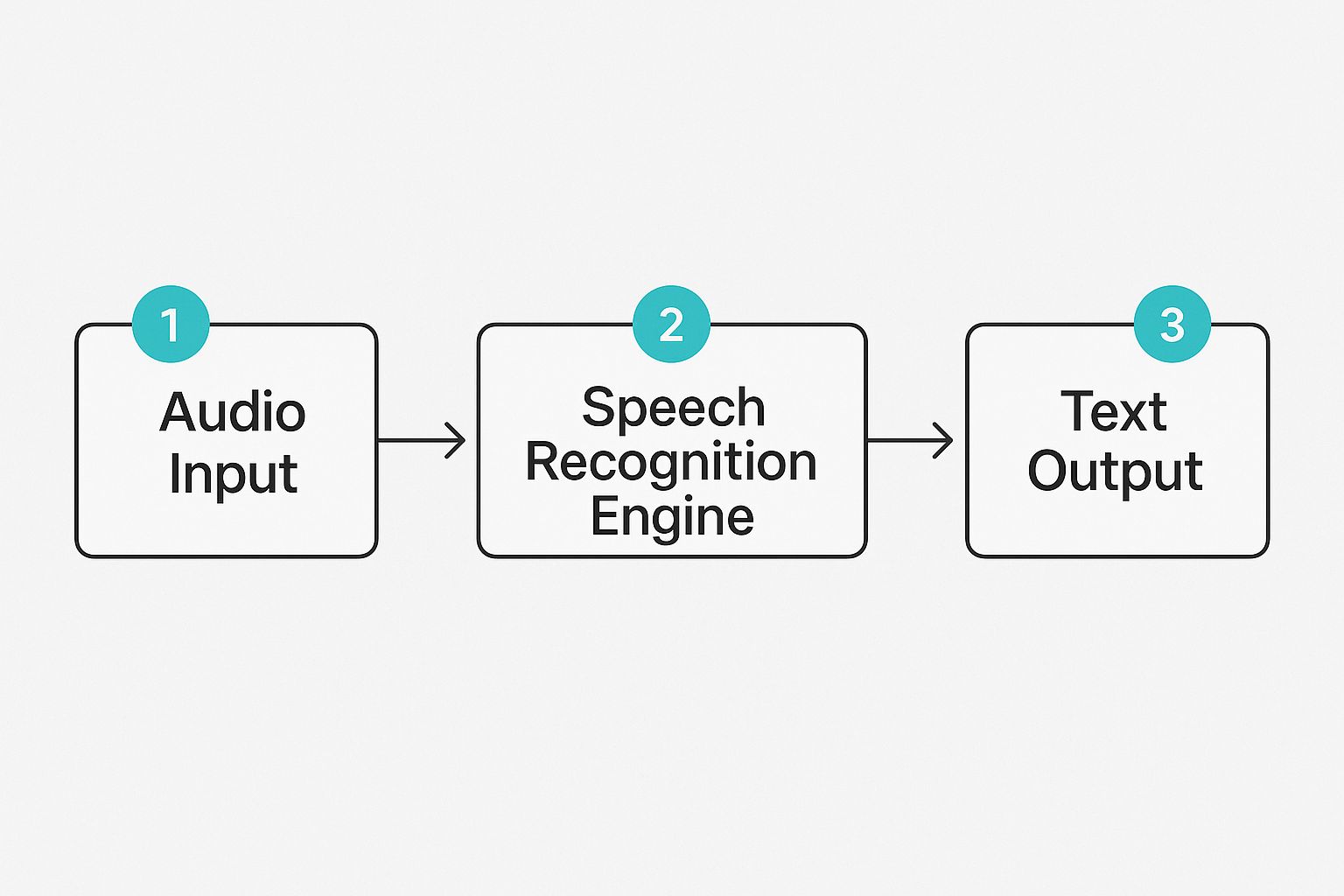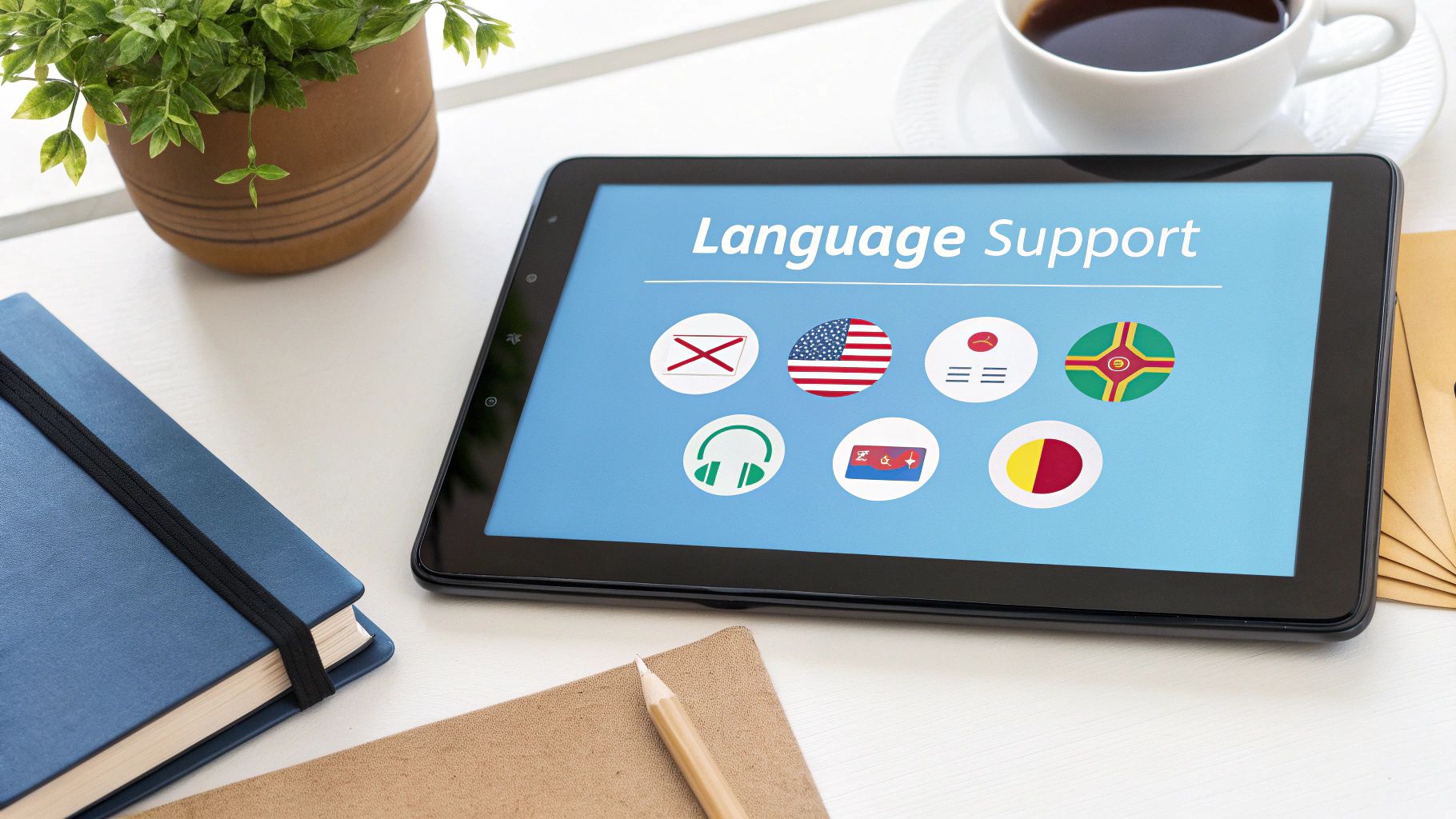Have you ever wished you had a helper who could type as fast as you can talk? That’s what speech-to-text software does. It’s a tool that listens to your voice and turns your words into writing on a screen.
It's like a magic helper that types for you.
What Is Speech to Text Software?
Speech-to-text software is a smart tool that changes talking into typing. It’s what makes your parent's phone understand them. It’s also used in video games and by grown-ups at their jobs. You talk, and it types.
The goal is simple: to make it easy to write down your ideas. Instead of typing a long school report, you can just say it. This lets you use your hands for other things and gives you more time to think.
Why Everyone Is Talking to Computers
This is not just a toy. It's a tool that is getting very popular. A few years ago, the companies that make these tools made over $10 billion. Soon, they will make three times that much! Why? Because we all like talking to our gadgets, like smart speakers at home or phones in the car.
This software is also the first step for bigger tools, like a Voice AI Agent that can have a whole chat with you. It all starts with turning talking into words a computer can read.
The real magic is that it helps you write as fast as you can think. You can say your ideas right away, so you don't forget them while looking for the right keys on the keyboard.
How It Helps You Every Day
So, how does this help in real life? It helps with small things that slow us down. This chart shows how it solves common problems.
| The Problem You Face | How the Software Solves It |
|---|---|
| Typing is slow and hard. | You can "write" four times faster by talking, which saves time. |
| You can't listen and take notes at the same time. | You can record what's being said and get the typed words later. This helps you pay attention. |
| It's hard for some people to use a keyboard. | It lets people use their voice to control computers. This helps everyone use technology. |
| You have good ideas but find it hard to write them. | It lets you talk about your ideas out loud. It catches every word so you don't have to worry about spelling. |
This software is like a bridge. It connects the words you say out loud to a written copy you can keep forever.
It’s not just for computer experts. Kids can use it for schoolwork. Doctors use it to write down notes about their patients. It’s a helpful tool for anyone who needs to get words on a page. Here are its main superpowers:
- Saves Lots of Time: Most people can talk much faster than they can type. This software lets you write stories, answer emails, and take notes super fast.
- Helps Everyone Use Computers: For people who have trouble using their hands, this tool is amazing. It helps them use the computer with just their voice.
- Makes You a Super Worker: It can type up everything from a meeting for you. This means you can focus on the big ideas instead of just typing.
How a Computer Learns to Understand You
Have you ever wondered how your phone knows what you're saying? It’s not magic. It’s like a student who has learned a new language very, very fast. The speech-to-text software has to learn how sounds make words, and how words make sentences.
When you talk, your voice makes little waves in the air. The microphone on your phone or computer is like an ear. It catches those waves and turns them into a secret code the computer can read.
Breaking Your Words into Tiny Pieces
First, the software chops up your talking into the smallest sounds. These little sounds are called phonemes. For example, the word "cat" is made of three sounds: 'c', 'a', and 't'. These are like the building blocks for every word.
This first step is very important. If the software hears these little sounds wrong, the typed words will be wrong. It’s like trying to build a LEGO castle with the wrong shaped blocks. The whole thing will fall apart.
This picture shows how your voice turns into words on the screen very quickly.


The software is like a super-fast translator. It turns the sounds you make into words you can read.
Guessing the Right Word
After breaking down the sounds, the computer has to match them to words it knows. It looks through a giant dictionary inside its brain. This dictionary has millions of words and the sounds that make them.
This part is tricky. Many words sound the same. For example, how does it know if you said "to," "too," or "two"? They all sound alike!
This is where the software gets really smart. It doesn’t just listen to one word. It looks at the whole sentence to find clues.
The secret trick is called context. The software looks at the words around the tricky sound to make a good guess. It's like a detective looking for clues to solve a mystery.
If you say, "I want to go to the store," the software sees the words "want," "go," and "store." It knows that "too" or "two" would not make sense in that sentence. Knowing the whole story helps modern speech-to-text software work so well. It’s not just hearing—it’s understanding.
The whole thing happens in three main steps:
- Step 1: Sound Check: The software listens and finds all the tiny sounds in your talking.
- Step 2: Word Matching: It looks for words in its dictionary that match those sounds.
- Step 3: Clue Check: It uses the other words in the sentence to pick the right word, like choosing between "their" and "there."
By doing these steps over and over at lightning speed, the software turns your talking into typed words. And just like a person, the more it listens to you, the better it gets at understanding your voice.
Real-World Uses You Might Not Expect


This tool is for more than just sending a quick text message. Grown-ups in all kinds of jobs use speech to text software in smart ways. It makes their work faster and their lives easier.
Let's look at some jobs where this tool is a secret helper. You might be surprised how many people use it.
Helping Doctors and Nurses
Think about a busy hospital. Doctors and nurses are always running around. After they see each person, they have to write down a lot of notes. Typing all of those notes takes a very long time.
This is where speech-to-text is a big help. A doctor can just talk into a microphone. The software types everything into the patient's computer file right away. This gives the doctor more time to take care of people. You can learn more about special medical voice to text applications.
When doctors can write notes quickly, they can spend more time helping patients get better. It’s a small change that makes a big difference.
This means less time doing paperwork and more time with people who are sick. It's a simple idea that helps a lot.
Assisting Students in the Classroom
Now, think about a student who has great ideas but has trouble writing or typing. School can feel very hard for them. For these students, speech-to-text software can be a super helper.
Instead of struggling with a keyboard, they can just say their ideas for a report. They can watch the words show up on the screen. It helps them get their ideas out without worrying about how to type them.
Here are a few ways it helps in school:
- Writing reports: Students can talk about their ideas out loud. The software types it all up, giving them a great start.
- Taking notes: They can repeat what the teacher says into their computer. This creates study notes for them automatically.
- Doing homework: They can say the answers to questions on a worksheet instead of trying to write in tiny boxes.
This makes school fair for everyone. It gives every student a chance to share what they know.
Changing How We Create and Play
This software is also making big changes in movies, news, and video games. A news reporter can record an interview on their phone. Then, they can use a tool to get all the words typed out in just a few minutes. This is much faster than typing it all by hand.
Even video games use it. In some games, you can use your voice to tell your character what to do. Imagine saying "open the door" and watching the door in the game open. It makes the game feel more real.
The companies that make these tools are growing fast. The market for these tools was worth about $4.42 billion in 2025. It is expected to grow to $8.57 billion by 2030.
From helping in hospitals to making school easier and creating fun games, speech to text software is a surprisingly big part of our world.
What to Look For: The Make-or-Break Software Features
Choosing the right speech-to-text software is like picking the right tool for a job. You wouldn't use a tiny spoon to dig a big hole, right? You need to find a tool with the right features for what you want to do.
There are many choices out there. Some are simple and good for writing down a quick note. Others are full of powerful tools for big jobs. Let's look at the most important features so you can find a tool that works for you.
H3: Accuracy: How Well Does It Actually Listen?
The most important thing is accuracy. This just means how good the software is at getting your words right. You want it to make as few mistakes as possible.
Think about a doctor telling the computer about a patient's medicine. If the computer types the wrong word, it could be a big problem. This is where you see the difference between simple tools and professional ones. The best software can be right 99% of the time! The best way to know is to try it with your own voice.
H3: Speaker Diarization: Who Said What?
Have you ever tried to read the typed words from a group chat where you can't tell who is talking? It’s hard to follow. Speaker diarization is a feature that fixes this problem.
It's a fancy name for a simple, smart trick. The software knows when a new person starts talking. It puts a label like "Speaker 1" and "Speaker 2" next to what they say. This is a huge help for typing up interviews or meetings with more than one person. Many new voice recorder with transcription app tools have this to make it easy to read conversations.
H3: Custom Vocabulary: Teaching the Software Your Lingo
Every job has its own special words. A doctor might say "stat," and a video game player might talk about "XP." Most simple speech-to-text tools will get confused by these words.
That’s why a custom vocabulary feature is so helpful. It lets you make your own dictionary. You can teach the software special names, game characters, or science words that you use a lot. Once you add a word, the tool will always get it right.
Being able to add your own words is a big deal. It's what makes a tool really understand you and your world.
This is why so many people are starting to use these tools. The world market for speech-to-text will grow from USD 5.28 billion in 2025 to over USD 20.20 billion by 2033. As more people use it for work, special features are a must-have. You can explore the full market research to learn more.
Here are some important features and what they mean.
Essential Features Explained Simply
| Feature Name | What It Means for You |
|---|---|
| Accuracy Rate | How many words the software gets right. The higher the number, the better! |
| Speaker Diarization | Knows who is talking and puts a label next to their words. |
| Custom Vocabulary | Lets you add your own special words, like names or school subjects. |
| Timestamping | Puts a time next to the words so you can find that spot in the audio. |
| Real-Time Transcription | Types the words as you are talking, like captions on a video. |
| Multi-Language Support | Can understand and type in different languages. |
Knowing about these features will help you pick the best software for you.
Keeping Your Spoken Words Private


When you talk to a speech-to-text software, have you ever wondered where your words go? It's a good question. You might be talking about a secret school project or a private family story.
It’s important to know what happens to your voice. Most of these tools need the internet to work. They send your talking to a big, powerful computer far away called "the cloud." That computer does the hard work of turning your voice into words.
Think of it like telling a secret. Using a tool that sends your voice to the cloud is like yelling your secret in a crowded lunchroom. You don't know who is listening or what they will do with it.
How to Keep Your Secrets Safe
Luckily, there is a safer way. It's like whispering your secret to your best friend. It’s called on-device processing. This means the software does all the work right on your own phone or computer.
Your voice never leaves your device. It is not sent over the internet to a faraway computer. This is the safest way to use this tool, especially if you are talking about private things.
With on-device processing, your private talks stay private. The software listens to you locally, so you are in control of your words.
This also means the tool can work even when you don't have internet. This is great for when you are in a car or somewhere with bad Wi-Fi. For people in jobs like healthcare or law, this feature is not just nice—it's a must-have.
Why This Matters for You
Choosing a tool that keeps your words private gives you peace of mind. You can work on your secret project without worrying that someone else will see it. It’s about being smart and choosing who to trust with your words.
Being private doesn't mean it's slow. Sometimes, doing the work right on your device is even faster than sending it to the cloud and back. The best tools are both safe and fast. You can learn more about what influences speech-to-text accuracy.
Before you pick a tool, ask these simple questions:
- Where do my words go? Do they stay on my computer, or are they sent to the cloud?
- Does the company save my recordings? If they do, why and for how long?
- Can this tool work without the internet? This is a good clue that it works on your device.
By asking these questions, you can pick a speech-to-text software that not only helps you work faster but also keeps your words safe.
How to Choose the Right Software for You
Picking the right speech-to-text software is like picking a pet. You wouldn't get a big, energetic dog if you live in a tiny apartment, right? The best tool is the one that fits your life and what you want to do.
You don’t have to be a computer expert to choose. You just need to answer three easy questions. Once you know the answers, you can find a tool that is perfect for you.
What Is Your Main Goal?
First, what do you need the tool for? Think about what you will use it for most of the time. Do you just want a faster way to send a text message? Or are you a student who needs to type up a long talk from your teacher?
A simple, free tool is probably fine for writing short emails. But if you are a writer working on a book, you will need a stronger tool with more power.
Think of it like this: you can use a small shovel to plant a flower, but you need a big bulldozer to build a new playground. Pick the right tool for the size of the job.
Big jobs, like typing up a whole day of meetings, need software made for that kind of work. These powerful tools have special features to make big jobs much easier.
How Perfect Does It Need to Be?
Next, think about mistakes. Is it okay if the software gets a few words wrong? Or does every single word need to be exactly right?
If you are making a grocery list, a few mistakes don't matter much. But if a doctor is writing down medicine instructions, one wrong word could be dangerous.
For important jobs, you need software with a very high accuracy rate. Think of these tools as expert typists who almost never make a mistake. They are built for times when getting it right is the most important thing.
What Is Your Budget?
Finally, let’s talk about money. How much do you want to spend? The good news is there are some great tools that are free. These are good for simple, everyday tasks. They are also a great way to try out the technology.
If you are new to this, looking at the best free transcription software is a smart idea. You can try different tools without spending any money.
But, if you need that super-high accuracy or special tools for your job, you will probably need to pay. It’s like buying a good tool that will last a long time. A professional artist buys better paint brushes to make better art. The same idea is true here.
By thinking about your goal, how perfect it needs to be, and your budget, you can choose the perfect speech-to-text software for you.
Common Questions About Speech-to-Text
It's normal to have questions about a new tool. Let's answer some of the most common questions people have about speech-to-text software. Knowing these things will help you feel good about using it.
These are the things people really want to know.
Does It Understand My Accent?
Yes, most of the time it can. New speech-to-text tools are very good at understanding how different people talk. The computer brain has listened to voices from all over the world. It has learned all the different ways people say words.
But some tools are better at this than others.
My best tip? Always try the free version first. It’s the only way to know if a tool can understand your voice. The best programs will even learn how you talk over time and get even better.
What About Background Noise?
This can be a problem. Think about trying to talk to a friend at a loud party. It's hard to hear them. The software has the same problem if a dog is barking or a TV is on nearby.
To get the best results, find a quiet place to talk. It makes a big difference. But many of the best tools now have a noise cancellation feature. This works like a filter. It helps the computer hear your voice and ignore all the other sounds. If you work in noisy places, this is a great feature to have.
Will It Know My Industry Jargon?
This is a big question for people who have jobs with special words. If you are a doctor talking about a "subdural hematoma" or a lawyer talking about an "injunction," you need a tool that knows those words. The good news is that many professional tools are made for jobs like medicine and law. They already know the special words.
They do this with a feature called custom vocabulary. It’s a real game-changer. Here's how it works:
- For Grown-ups: You can add all the special words you use for your job, like client names or product names.
- How It Works: You just teach the software the new word one time by adding it to its dictionary.
- The Result: After that, it will always know that word and spell it right.
If your job uses special words, a tool with a good custom vocabulary feature is a must-have. It’s what makes a tool perfect for your work.
Ready to stop typing and start talking? WriteVoice can help you write up to four times faster in any app you use. With over 99% accuracy and a commitment to your privacy, it's the perfect tool for professionals. Try it for free.
